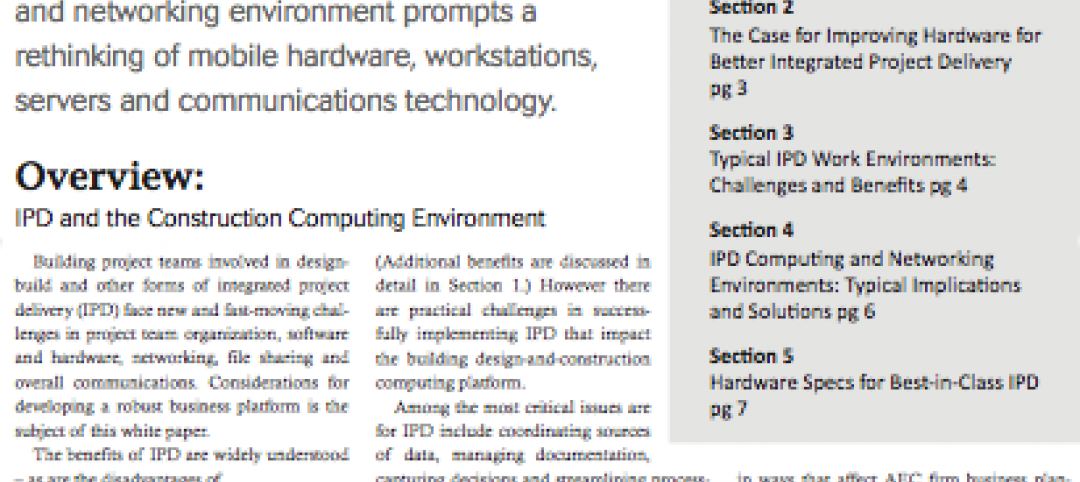The Design-Build Institute of America (DBIA) has released “Universally Applicable Best Practices Applying to Any Project Type, in Any Market Sector, of Any Size.” Based on research, case studies, and industry input, DBIA has identified design-build best practices.
“The 10 Design-Build Done Right Best Practices serve as a single source that clearly defines design-build fundamentals to significantly enhance superior project outcomes,” says Lisa Washington, CAE, Executive Director/CEO, DBIA. “With design-build currently at 40% of all non-residential design and construction, the impetus for owners to engage in Design-Build Done Right is at an all-time high. By applying these ten DBIA Best Practices, owners and practitioners will unlock the inherent value of design-build project delivery.”
Best practices supporting effective design-build start during the owner’s procurement decision-making process and span through project execution. Each DBIA Best Practice is supplemented by several techniques that provide guidance on specific ways to implement the best practice. The combination of best practices and implementing techniques are the basis for Design-Build Done Right.
Design-build requires more than a good contract and appropriate risk allocation. Everyone from the owner to the subcontractors must understand the process, the expectations and fully engage in the collaboration. DBIA categorizes the 10 best practices (and nearly 50 supporting implementing techniques) into three areas:
Procuring Design-Build Services
1. An owner should conduct a proactive and objective assessment of the unique characteristics of its program/project and its organization before deciding to use design-build.
2. An owner should implement a procurement plan that enhances collaboration and other benefits of design-build and is in harmony with the reasons that the owner chose the design-build delivery system.
3. An owner using a competitive design-build procurement that seeks price and technical proposals should: (a) establish clear evaluation and selection processes; (b) ensure that the process is fair, open and transparent; and (c) value both technical concepts and price in the selection process.
Contracting for Design-Build Services:
4. Contracts used on design-build projects should be fair, balanced and clear, and should promote the collaborative aspects inherent in the design-build process.
5. The contract between the owner and design-builder should address the unique aspects of the design-build process, including expected standards of care for design services.
6. The contracts between the design-builder and its team members should address the unique aspects of the design-build process.
Executing the Delivery of Design-Build Projects:
7. All design-build team members should be educated and trained in the design-build process, and be knowledgeable of the differences between design-build and other delivery systems.
8. The project team should establish logistics and infrastructure to support integrated project delivery.
9. The project team, at the outset of the project, should establish processes to facilitate timely and effective communication, collaboration, and issue resolution.
10. The project team should focus on the design management and commissioning/turnover processes and ensure that there is alignment among the team as to how to execute these processes.
DBIA recognizes that there are real-world differences among design-build market sectors (e.g., water/wastewater, transportation, federal projects), and that specific implementation techniques might differ slightly from one market sector to another. For this reason, DBIA is in the process of working with market sector experts on sector-specific documents to supplement the overall best practices released today. These will provide more detailed guidance on how to put these best practices and implementing techniques into use in different design-build market sectors.
DBIA intends to continually update its portfolio of publications, tools and other resources so that design-build stakeholders will have access to leading-edge information that will allow them to achieve Design-Build Done Right in accordance with the concepts expressed in this document.
Related Stories
| Aug 19, 2011
Thought Leader: Boyd R. Zoccola, chair and chief elected officer of BOMA International
Boyd R. Zoccola is Chair and Chief Elected Officer of BOMA International. A BOMA member since 1994, he has served on the Executive, Finance, Investment, and Medical/Healthcare Facilities Committees. An Indiana Real Estate Principal Broker and a board member of the Real Estate Round Table, he is Executive Vice President of Hokanson Companies, Inc., of Indianapolis, and has been involved in the development of $600 million worth of real estate. On a volunteer basis, Zoccola was president of Horizon House and a board member of Girls, Inc. He holds a BA in biology from Indiana University.
| Aug 19, 2011
How and why AEC professionals choose flooring systems
Design and construction professionals who completed our flooring survey had strong opinions about their preferred flooring type.
| Aug 19, 2011
Underfloor air distribution, how to get the details right
Our experts provide solid advice on the correct way to design and construct underfloor air distribution systems, to yield significant energy savings.
| Aug 19, 2011
Enhanced acoustical design
Ambient noise levels in some facility types are trending up and becoming a barrier to clear communication between building occupants.
| Jul 22, 2011
The Right Platform for IPD
Workstations for successful integrated project delivery, a white paper by Dell and BD+C.
| Jul 22, 2011
High-performance windows and doors
Learning objectives After reading this article, you should be able to: Understand issues of thermal performance and energy efficiency in relation to window and door systems; describe optimal detailing of the window-wall interface and how it contributes to building performance, sustainability, and occupant well-being; understand how durability contributes to sustainable windows/doors; and list sustainable O&M requirements for window and door systems.
| Jul 21, 2011
Falling Architecture Billings Index reflects decrease in design demands
This months Architecture Billings Index (ABI), provided by the American Institute of Architects, is almost a full point lower than last month’s reported score. June’s reading of 47.2 was short of the required 50 to achieve billings increases, making July’s reading of 46.3 an unwelcome sign of market tidings.
















